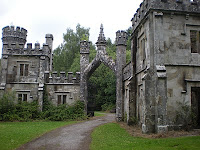
Certainly an important part of local history is the famine. We wrote about the “good’ vs. “bad” landlords yesterday. However, we learned another interesting tidbit about the bad landlord, Keily-Usher, today, when we visited his “folly,” “The Towers.” In the 1830s, before the famine hit, his wife was engaged in a jealous battle with her sister-in-law. The sister-in-law, with her husband, lived in a nearby castle (the one across the river from us), while the Ushers were only in a “Great House.” They wanted a castle as grand as the one owned by the sister-in-law. They began by having a set of gothic-style towers built on the approaches to what was to become their new castle.

However, before they could build their castle, they ran out of money. It was their feverish intention to raise enough money to build that castle (which never got built) that led to their cruel treatment of their tenants, throwing them off the land in order to replace agriculture with cattle and sheep. When the potato blight (the same one that hit western Massachusetts last summer) hit in 1841, and people began to starve, he did not alter his behavior, but instead used their poverty and inability to meet their rents as an excuse to throw them off the land and burn down their crofts so they could not return. The harsh plantation system turned the potato blight into a famine, as English landowners and members of the British Parliament typically showed callous disregard for the Irish farmers, and, as you’ve all heard, continued to export grain from Ireland, enough grain to have fed most, if not all, of the country. One third of Ireland’s 8 million inhabitants died in the famine (1841-49), and the nearby towns all have mass famine graves. Some local towns had 50% mortality from starvation and associated disease. Another third of the population emigrated. No wonder the remaining third were so angry that they continued their pattern of uprisings and rebellions, finally winning their cause of Irish home rule in 1921. But the Ushers never managed, despite their horrible behavior, to make the kinds of profits they needed from their estate, probably because they impoverished and weakened their people so much. They lived their whole married life in that “great house’ that they saw as incommensurate with their rank, and never got to have the pleasure of riding in a carriage up through those towers on their way to an ornate castle. They died in the early 1850s. Supposedly their son, who was nicer than them (Donald says that wouldn’t be hard), was able to turn a profit from the estate, and built a house for himself to live in. It, however, somehow did not last the 150 years or so since it must have been built. They are gone from the landscape, although remembered bitterly, unlike the Cavendishes.
Today, the Duke and Duchess of Devonshire are quite liked and well-thought-of by the locals. They are seen as having been good landlords during the famine, and are seen as doing a lot today for the good of the local economy and labor force. They certainly invest in the town of Lismore, providing work for many and continuing to have a presence. The locals speak affectionately of them, but the idea of English lords owning large swaths of Ireland and ancient castles still leaves us both uneasy. One wonders how the locals felt about the Duke of Devonshire in 1880 or 1916?
No comments:
Post a Comment